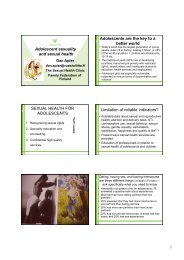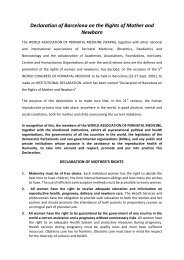Journal of Contraception Reproductive Health Care - The European ...
Journal of Contraception Reproductive Health Care - The European ...
Journal of Contraception Reproductive Health Care - The European ...
You also want an ePaper? Increase the reach of your titles
YUMPU automatically turns print PDFs into web optimized ePapers that Google loves.
<strong>The</strong> 8th Congress <strong>of</strong> <strong>The</strong> <strong>European</strong> Society <strong>of</strong> <strong>Contraception</strong> Abstracts <strong>of</strong> Invited Speakers<br />
IS-13<br />
<strong>Health</strong> benefits – breast and bone<br />
A. Glasier<br />
Family Planning and Well Woman Services, Dean Terrace Clinic, Edinburgh, UK<br />
<strong>The</strong> evidence for non-contraceptive benefits <strong>of</strong> hormonal contraception on breast and bone relates only to the combined oral<br />
contraceptive pill (COC). Most reviews on the topic state that the pill is associated with a reduced risk <strong>of</strong> benign breast disease<br />
(BBD) and that it is ‘good for bone’.<br />
<strong>The</strong> data on BBD are scanty, somewhat old and, <strong>of</strong> course, observational. It seems counter-intuitive that COC use should be<br />
associated with an increased risk <strong>of</strong> breast cancer while at the same time preventing benign disease. <strong>The</strong> beneficial effects, if any,<br />
may be limited.<br />
<strong>The</strong>re are more data on the effect <strong>of</strong> COC on bone and they are more recent. However studies on the effects <strong>of</strong> contraception<br />
on bone mineral density are not easy to do since there are many confounding variables.<br />
<strong>The</strong> quality <strong>of</strong> the research is very variable, but the better studies tend towards demonstrating no significant effect on the pill on<br />
bone mineral density. <strong>The</strong> limited amount <strong>of</strong> observational data is even more difficult to interpret but it is hard to conclude that<br />
use <strong>of</strong> the pill is associated with a reduced risk <strong>of</strong> osteoporotic fracture.<br />
<strong>The</strong> benefits <strong>of</strong> combined hormonal contraception on breast and bone may well have been overstated.<br />
IS-14<br />
Non-contraceptive effects – dysfunctional uterine bleeding<br />
I. Milsom<br />
Department <strong>of</strong> Obstetrics & Gynecology, Sahlgrenska Academy at Göteborg University, Sweden<br />
Menstrual disorders such as menorraghia and dysmenorrhea have been reported to seriously affect approximately 2.5 million<br />
women annually in the USA and cost US industry 8% <strong>of</strong> the total wage bill. Dysmenorrhea is probably the commonest form <strong>of</strong><br />
menstrual disorder with a reported prevalence <strong>of</strong> 50–90% among young women. In Sweden 15% <strong>of</strong> young women have been<br />
reported to suffer from dysmenorrhea which causes absenteeism from school or work every month. Approximately 10% <strong>of</strong> fertile<br />
women suffer from menorraghia, defined as a menstrual blood loss <strong>of</strong> 480 ml. Excessive blood loss may lead to iron deficiency<br />
anaemia and ultimately necssitate hysterectomy.<br />
<strong>The</strong> use <strong>of</strong> different contraceptive techniques has been shown to influence menstrual blood loss and the occurrence <strong>of</strong> dysmenorrhea.<br />
Some contraceptive methods have been reported to decrease the occurrence <strong>of</strong> menorraghia while other methods have<br />
been reported to increase the prevalence <strong>of</strong> dysmenorrhea and menorraghia<br />
Combined oral contraceptives (COC) are generally accepted to provide effective pain relief for 70–80% <strong>of</strong> women with primary<br />
dysmenorrhea. This opinion has however been contested in a recent Cochrane review. COC’s have also been reported to<br />
reduce menstrual blood loss by approximately 50%. On the other hand copper (Cu) intrauterine devices (IUD) have been<br />
reported to increase menstrual blood loss by approximately 50% and dysmenorrhea has been reported to be more common<br />
among users <strong>of</strong> a Cu-IUD.<br />
Thus the choice <strong>of</strong> contraceptive method can influence the occurrence <strong>of</strong> these conditions and in some cases contraceptive<br />
methods can be used as an effective treatment for dysfunctional uterine bleeding. <strong>The</strong> scientific evidence behind the influence <strong>of</strong><br />
contraceptive methods on dysfunctional uterine bleeding will be described.<br />
18 <strong>The</strong> <strong>European</strong> <strong>Journal</strong> <strong>of</strong> <strong>Contraception</strong> and <strong>Reproductive</strong> <strong>Health</strong> <strong>Care</strong>








